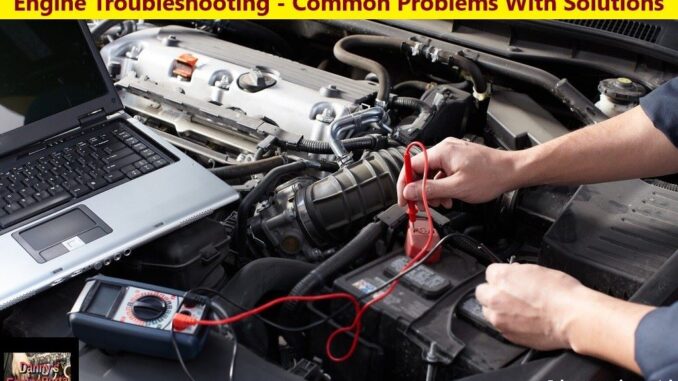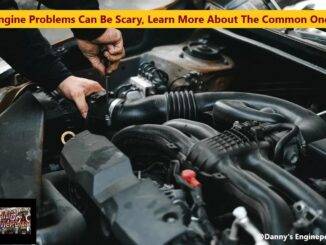
Engine troubleshooting, is the most important part of any automotive repair.
So, by proper engine troubleshooting, you won’t waste time and money fixing things that don’t need to be fixed.
Engine troubleshooting as early as possible is useful to prevent further issues down the road.
Engine troubleshooting answers to some of the most frequently asked questions about automotive repair and service.
In comparison to wrenching, engine troubleshooting requires a more in-depth knowledge of the workings of an engine. So, a mechanically inclined person can easily change a part and do a good job of it. But, it takes a higher level of study to be able to accurately determine which part needs to be changed. Even a battery or starter.
Another common mistake in engine troubleshooting is falsely condemning a part that is really just out of adjustment.
Your Vehicle Is Sending Out Smoke Signals (engine troubleshooting)
Black Smoke Is Coming From Your Exhaust
Most of the time this is because excessive fuel is being burnt. And, is usually because your air fuel mixture is too rich. But, don’t rule out a clogged air filter. However, if its not clogged there may be a problem with a sensor controlling the vehicles fuel injection.
One the other hand, if your vehicle has a carburetor, then the choke plate may be stuck. Also, another possibility is a vacuum leak.
White Smoke Is Coming From Your Exhaust
First, when a cold engine is started, any condensation that has formed in the exhaust will be burned off. So, this is normal and nothing to worry about. But, if you see white smoke coming out of the exhaust at all engine temperatures.
Then, this is an indication of a blown head gasket or possibly, a crack in the head, intake or cylinder. Basically, what is happening is coolant is leaking into the cylinder and is being burned off as steam.
Blue Smoke Is Coming From Your Exhaust
So, this is a definite indication that this engine is burning oil. The most common cause for this is, bad rings and is most likely from high mileage. Furthermore, an engine with bad rings will also show signs of power loss, especially when going up hills.
Another cause of blue smoke is bad valve stem seals. Usually, the smoke is more noticeable during acceleration. Lastly, if your vehicle has a turbo charger, then it may have leaking turbocharger seals.
Your Vehicle Smells Like, Rotten Eggs (engine troubleshooting)
The rotten egg smell is the result of unburned fuel vapors, reacting with chemicals in the catalytic converter. Usually, a sign that your air fuel mixture is too rich.
But, don’t rule out a clogged air filter. However, if its not clogged there may be a problem with a sensor controlling the vehicles fuel injection. In addition, if your vehicle has a carburetor the choke plate may be stuck. Also, don’t rule out a vacuum leak.
Your Engine Seems To Lack Power
Your Vehicle Lacks Power On Flat Roads, As Well As Hills
This usually indicates, a problem in the ignition or fuel system, or possibly a clogged catalytic converter. If the vehicle, doesn’t seem to have the top speed it used to, then suspect a clogged converter. If the engine runs rough, especially when idling, it may be due to, old/failing spark plugs and wires.
Also, look for a fuel delivery problem in the carburetor or possibly, a clogged fuel injector. Lastly, look for weak compression due to bad rings or valves, possibly from high mileage.
What If Your Vehicle Lacks Power On Hills, But Is Fine On Flat Roads
Pre-ignition
So, if you also notice a pinging noise, then this would indicate a pre-ignition condition. Pre-Ignition means the air fuel mixture in the engine’s combustion chambers is igniting earlier than it should. If you have been filling your tank with low octane fuel, this could be the cause.
Consequently, Low Octane Fuel Burns Easily And Under Certain Conditions Will Self-Ignite. Before, The Piston Reaches The Top Of The Cylinder:
- So, engines make their peak power, when the plugs fire, while the piston is at the top of the cylinder. But, here you have pre-ignition and power loss. So, try using a higher grade of fuel.
- In addition, if your engine is running hot, this could also trigger pre-ignition. During very hot days your engine will run hotter, but this is normal and unavoidable. However, if your engine is running hot when it shouldn’t, then you need to look into what’s causing, abnormal overheating.
- Thin air can also cause pre-ignition. If you are driving in high altitude areas, try using a higher octane/grade of fuel. High octane fuels burn slower and are therefore, resistant to preignition.
Rings or Valves
Finally, you may have weak compression due to bad rings or valves.
Your Vehicle Shakes, While Idling (engine troubleshooting)
This is a telltale sign that the engine is misfiring, on one or more cylinders. This may be as simple as, spark plugs or spark plug wires. But, may also be a more serious internal engine problem, like a burned valve.
Your Engine Has Hesitation Or Stalls While Accelerating
If This Happens Only In The Morning The Culprit May Be Moisture In The Distributor Cap.
Why ? Because, during the night condensation or moisture can form on the inside of the distributor cap. Consequently, due to cold and wet weather and the fact that the engine is cold. This moisture allows electrical current to arc inside the distributor cap. And this arcing, is what causes the engine to hesitate or stall.
A Vacuum Leak Could Be The Cause, If This Problem Has Slowly Gotten Worse Over Time.
Why ? Vacuum leaks, typically start out small, almost unnoticeable and gradually become worse. And, are due to heat and pressure inside the engine. So, any vacuum leak will intermittently throw off the air fuel mixture that enters the engines combustion chamber.
This results in a hesitation, jerking or in extreme situations, stalling. So, check all hoses and clamps for loose connections or cracks.
If The Hesitation Has Stayed The Same Over Time, Then You May Have A Faulty Accelerator Pump.
Why ? The accelerator pump gives the engine the extra fuel it needs, to accelerate smoothly. A faulty accelerator pump will either not work at all or only work intermittently. In either case, the result is usually hesitant or jerky acceleration. And, sometimes stalling.
If The Hesitation Has Stayed The Same Over Time, Then You May Have A Bad (TPS).
Why ? The (TPS) measures how far the throttle is open and sends this information to the vehicle’s computer. As a result, it calculates the precise amount of fuel, to inject into the engine. However, a faulty (TPS) will adversely affect the injection of fuel into the engine. And, often results in hesitant or jerky operation. And, sometimes, stalling.
Your Engine Stalls, While Idling (Fuel Injected System)
If the engine will stay running when you give it more throttle, check the (IAC) bypass valve.
Why ? Because, when it is about to stall you are essentially compensating for, a faulty (IAC) bypass valve. So, by increasing the throttle you are giving the engine, enough fuel to stay running.
If The Stalling Only Occurs When The Engine Is Cold, You May Have A Problem With The Cold Start Valve.
Why ? This valve gives the engine more fuel for a richer air fuel mixture. Because, that is needed when the engine is cold.
Another Possibility Is, A Faulty Fuel Pressure Regulator. (engine troubleshooting)
Why ? The fuel pressure regulator, maintains proper fuel pressure to the fuel injectors. Problems with this device will likely result in a fuel starved engine, thus it will stall.
Your Engine Stalls, While Idling (Carbureted System)
If The Engine Stays Running When You Give It More Throttle. Then, The Idle Speed May Be Set Too Low.
Why ? By giving the engine more fuel, when it is about to stall, you are compensating for a low idle. So, by increasing the throttle, you are giving the engine enough fuel to stay running.
If The Stalling At Idle Only Occurs When The Engine Is Cold. Then, You May Have A Problem With The Choke.
Why ? The choke restricts the amount of air going into the carburetor. As a result, causing a richer air fuel mixture that is needed when the engine is cold. So, if the choke is stuck in the open position, then it will be creating a lean condition. Rather than the rich condition we need, when an engine is cold and consequently stalling.
Another Possibility Is, An Obstruction In The Fuel Line Or Carburetor. (engine troubleshooting)
Why ? An obstruction in the fuel line or carburetor would restrict the fuel flow to the engine, resulting in stalling.
When Your Engine Oil Warning Light, Flickers:
- The oil level may be low. So, check the level and refill it to the correct level.
- The oil may be of the wrong grade. So, check for correct grade of oil. Refer to owner manual or bring vehicle in for inspection.
- Oil sending unit may be defective. Test the sending unit and replace if faulty.
- You may have a clogged oil pick up screen. Remove the oil pan and replace or clean screen.
- Oil pressure is low. You may have worn out crank bearings or oil pump.
When Your Heater Blows, Cold Air (engine troubleshooting)
- You may have, a bad thermostat.
Why ? The thermostat is a valve that opens and closes to regulate coolant flow through the engine. So, when the coolant is cold, the valve will restrict coolant flow, allowing the heat of the engine to increase. Then, as the coolant temperature increases, the thermostat opens to increase coolant flow.
A thermostat has a heat rating that dictates, how high the coolant temperature will be before it is fully open. A common thermostat will be 195 degrees F. First thing to do is to make sure that the coolant temperature is up to operating temperature, 195 degrees F.
A quick check by feeling the radiator hoses would tell you if it is hot. Using a thermometer, taped to the upper hose of the radiator, will tell you exactly where you are. So, if it isn’t hot enough, change the thermostat. Also, check the radiator cap.
Your Coolant Level, May Be Low.
Why ? A low coolant level will reduce the flow to the heater core.
You May Have, A Clogged Or Restricted Heater Core.
Why ? If your heater core is restricted or clogged then coolant isn’t flowing through as it should. As a result, it is cooling down and that translates into your heater blowing cool or warm air.
You May Have, A Bad Clutch Fan, Or Fan Switch. (engine troubleshooting)
Why ? If you have a clutch fan, it may be turning too fast, keeping the coolant temperature too low. And, if you have a electric fan, it may be running too long or staying on.
And, in the worst case, you may have a blown head gasket.
Your Engine Uses Coolant, But You Don’t See Any Leaks
So, Your Intake Gasket May Be Leaking.
Why ? The intake gaskets seal coolant, that flows between, the two sides of your engine. Many times when these gaskets lose their ability to seal, they allow coolant to leak into your engines crankcase.
First, check your oil level. If the oil level is high, then you likely have coolant getting into your crankcase. Immediately have your mechanic inspect your engine. Do not drive or operate your vehicle with this condition as bearing failure will be likely. As, the coolant in the oil takes away the oils lubricating properties.
In Summary: Engine Troubleshooting
So, engine troubleshooting takes years of experience. But, anyone can make an effort to diagnose them. So, next time your vehicle has an issue, don’t rely on a mechanic to tell you what’s wrong. Finally, try using your senses to get an idea, of what’s causing the problem.
Thank You !!




